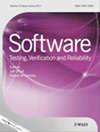多任务控制软件的OS in - the - Loop验证
IF 1.2
4区 计算机科学
Q3 COMPUTER SCIENCE, SOFTWARE ENGINEERING
引用次数: 0
摘要
控制安全关键型物联网设备的嵌入式控制软件需要系统和全面的验证,以确保设备的安全运行。然而,由于嵌入式控制软件的高度复杂性,其特点是频繁使用多任务、中断和定期报警,因此在该领域进行严格的验证是不可实现的。认识到两个主要因素,可扩展性和准确性,很难同时实现,但对于该领域的有效和高效验证至关重要,本工作引入了一种特定领域的组合OS - in - the - Loop (OiL)验证方法,并着手推动实现这两个因素的边界。建议的方法(1)使用受控并发的概念对底层操作系统的行为进行建模,以限制搜索空间;(2)使用正式的操作系统模型执行控制器的异构组合,以降低验证复杂性;(3)利用最先进的验证技术,在给定的搜索深度内进行全面验证。本文章由计算机程序翻译,如有差异,请以英文原文为准。

OS‐in‐the‐Loop verification for multi‐tasking control software
Embedded control software that controls safety‐critical IoT devices requires systematic and comprehensive verification to ensure safe operation of the device. However, rigorous verification in this domain has not been feasible due to the high complexity of embedded control software, which is characterized by the frequent use of multi‐tasking, interrupts, and periodic alarms. Realizing that two major factors, scalability and exactness, are extremely difficult to achieve at the same time but critical for effective and efficient verification in this domain, this work introduces a domain‐specific compositional OS‐in‐the‐Loop (OiL) verification approach and sets out to push the boundary in achieving both factors. The suggested approach (1) models the behavior of the underlying operating system to limit the search space using the notion of controlled concurrency, (2) performs heterogeneous composition of controllers with the formal OS model to reduce verification complexity, and (3) utilizes state‐of‐the‐art verification techniques for the purpose of comprehensive verification up to a given search depth.
求助全文
通过发布文献求助,成功后即可免费获取论文全文。
去求助
来源期刊

Software Testing Verification & Reliability
工程技术-计算机:软件工程
CiteScore
3.70
自引率
0.00%
发文量
34
审稿时长
>12 weeks
期刊介绍:
The journal is the premier outlet for research results on the subjects of testing, verification and reliability. Readers will find useful research on issues pertaining to building better software and evaluating it.
The journal is unique in its emphasis on theoretical foundations and applications to real-world software development. The balance of theory, empirical work, and practical applications provide readers with better techniques for testing, verifying and improving the reliability of software.
The journal targets researchers, practitioners, educators and students that have a vested interest in results generated by high-quality testing, verification and reliability modeling and evaluation of software. Topics of special interest include, but are not limited to:
-New criteria for software testing and verification
-Application of existing software testing and verification techniques to new types of software, including web applications, web services, embedded software, aspect-oriented software, and software architectures
-Model based testing
-Formal verification techniques such as model-checking
-Comparison of testing and verification techniques
-Measurement of and metrics for testing, verification and reliability
-Industrial experience with cutting edge techniques
-Descriptions and evaluations of commercial and open-source software testing tools
-Reliability modeling, measurement and application
-Testing and verification of software security
-Automated test data generation
-Process issues and methods
-Non-functional testing
 求助内容:
求助内容: 应助结果提醒方式:
应助结果提醒方式:


